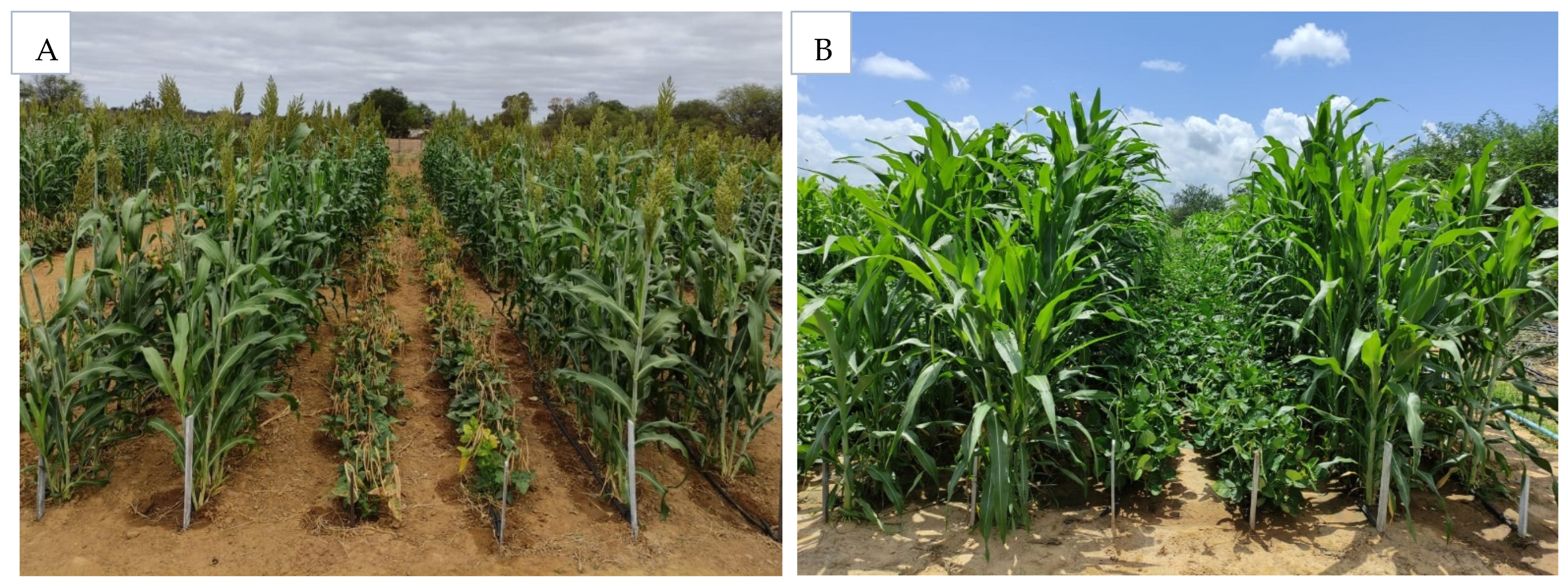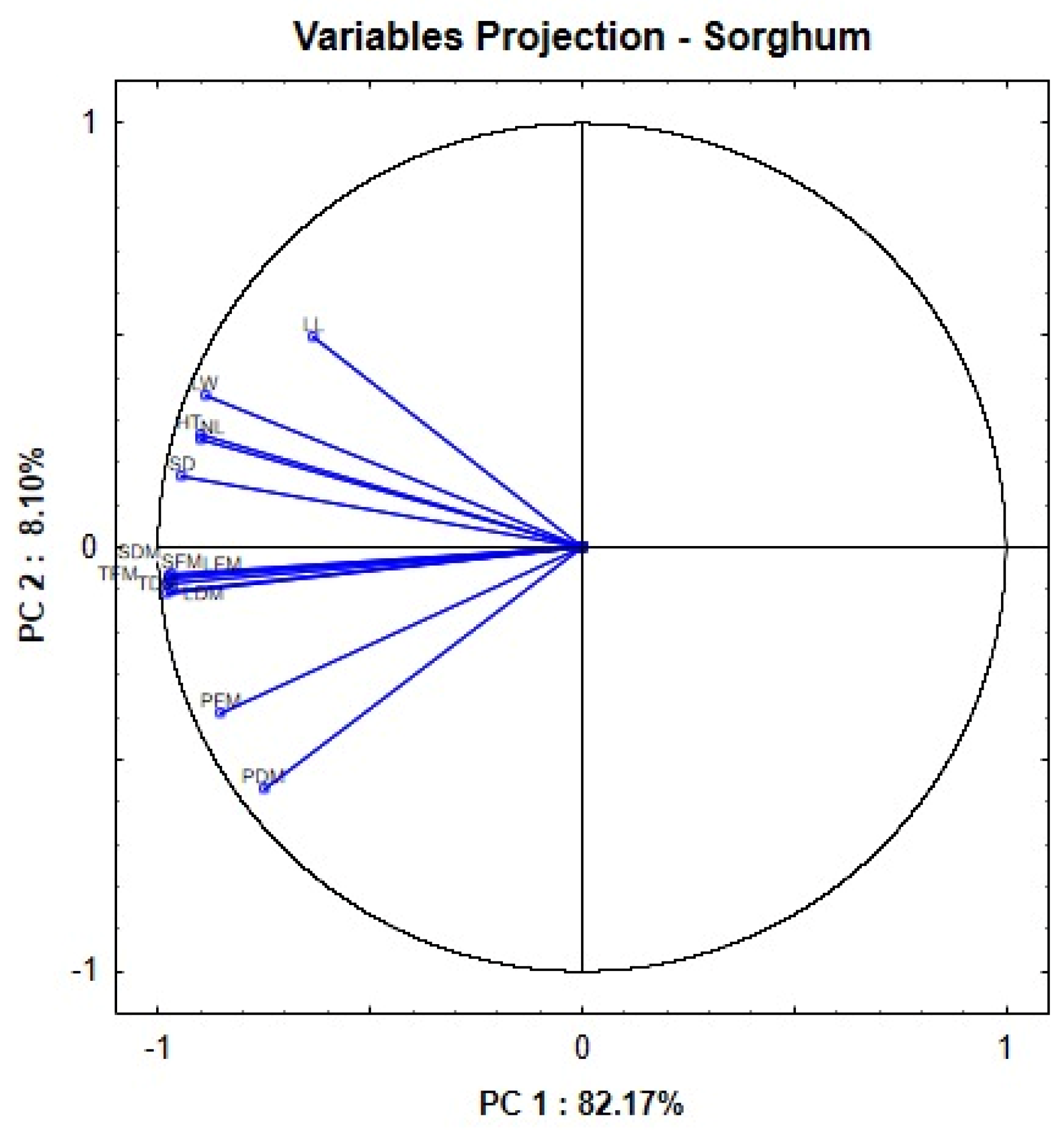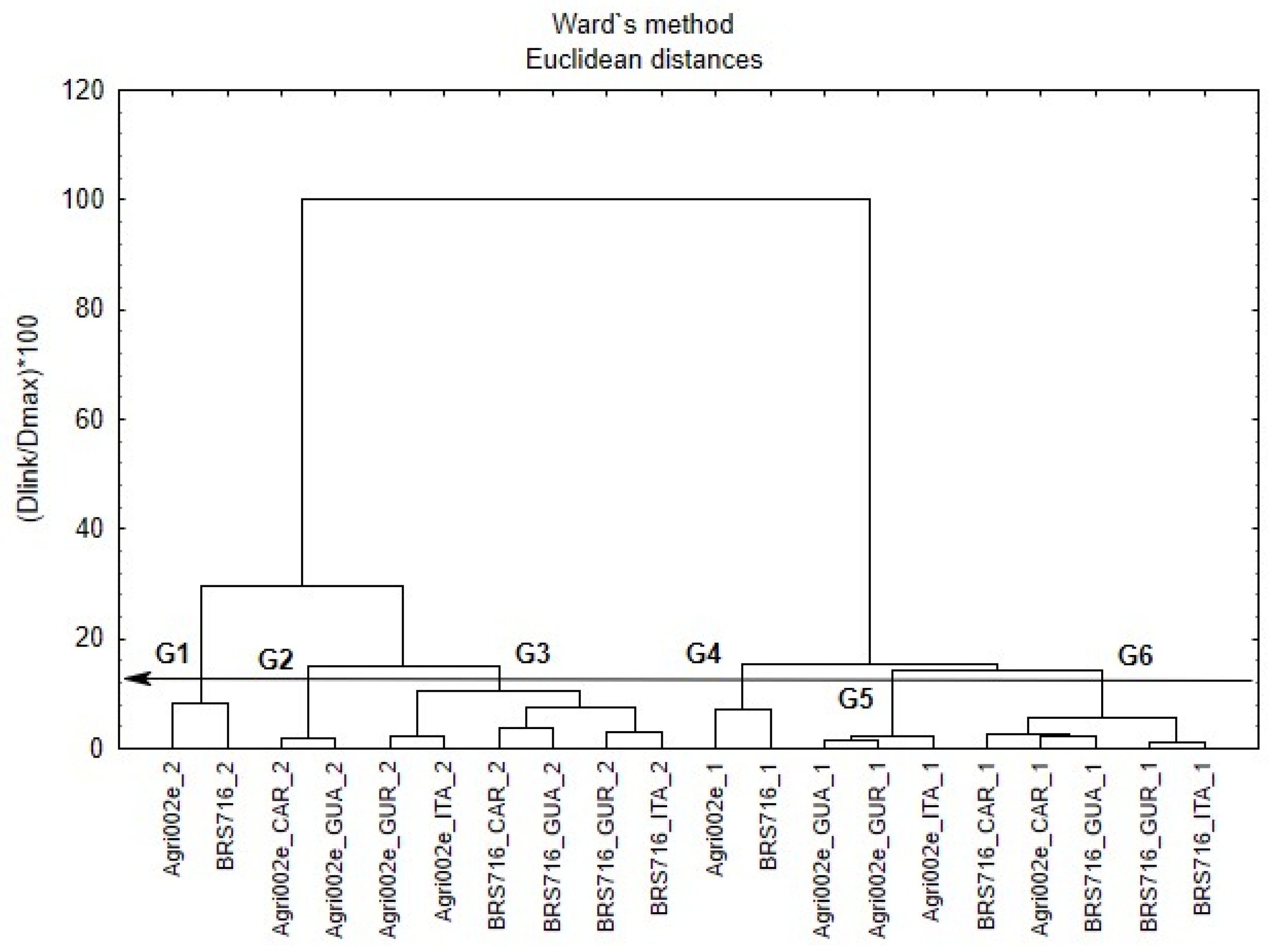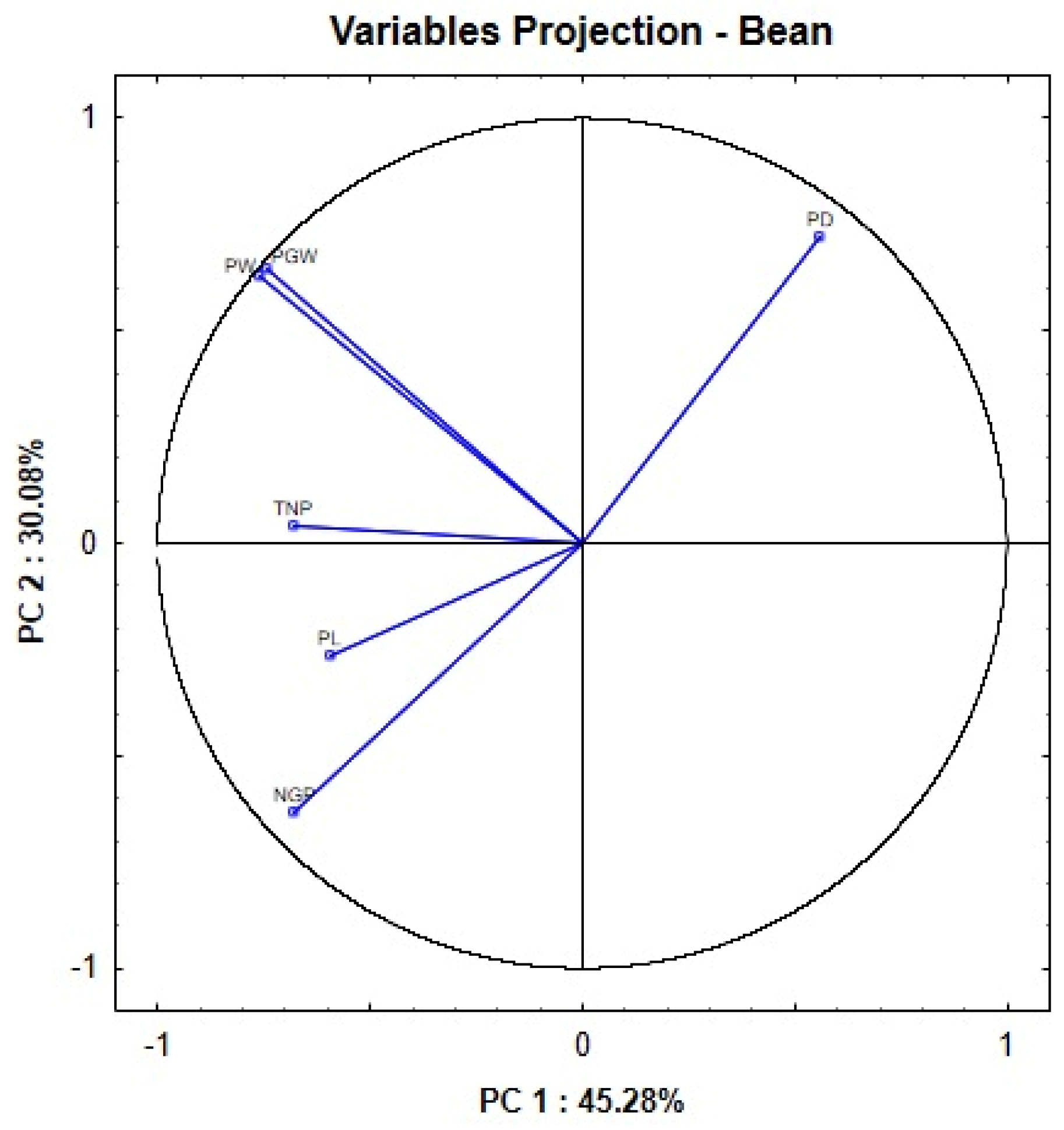Productive Performance of Biomass Sorghum (Sorghum bicolor (L.) Moench) and Cowpea (Vigna unguiculata (L.) Walp) Cultivars in Different Cropping Systems and Planting Times
Abstract
1. Introduction
2. Materials and Methods
2.1. Experiment Location
2.2. Experimental Design
2.3. Crop Implementation and Management
2.4. Agronomic Characteristics Evaluated
2.5. Statistical Analysis
2.6. Land Equivalent Ratio (LER)
3. Results
3.1. Biomass Sorghum
3.2. Cowpea
3.3. Land Equivalent Ratio (LER)
4. Discussion
5. Conclusions
Author Contributions
Funding
Data Availability Statement
Conflicts of Interest
References
- IPCC. Climate Change 2021: The Physical Science Basis. International Panel on Climate Change; IPCC: Geneva, Switzerland, 2021. [Google Scholar]
- Angelotti, F.; Giongo, V. Mitigation and adaptation actions in the face of climate change. In Rain-Dependent Family Farming in the Semi-Arid Region; Melo, R.F., Voltolini, T.V., Eds.; Embrapa: Brasília, Brazil, 2019; pp. 445–467. [Google Scholar]
- Giongo, V.; Salviano, A.M.; Angelotti, F.; Taura, T.; Leite, L.F.C.; Cunha, T.J.F. Low Carbon Technologies for Agriculture in Dryland: Brazilian Experience. In Climate Resilient Agriculture—Strategies and Perspectives; Rao, C.S., Shanker, A.K., Shanker, C., Eds.; InTech: London, UK, 2018; pp. 105–127. [Google Scholar] [CrossRef]
- Pereira, B.J.; Cecílio Filho, A.B.; Scala, N.L.J. Greenhouse gas emissions and carbon footprint of cucumber, tomato and lettuce production using two cropping systems. J. Clean. Prod. 2021, 282, 124517. [Google Scholar] [CrossRef]
- Sun, T.; Feng, X.; Lal, R.; Cao, T.; Guo, J.; Deng, A.; Zheng, C.; Zhang, J.; Song, Z.; Zhang, W. Crop diversification practice faces a tradeoff between increasing productivity and reducing carbon footprints. Agric. Ecosyst. Environ. 2021, 321, 107614. [Google Scholar] [CrossRef]
- Maitra, S.; Hossain, A.; Brestic, M.; Skalicky, M.; Ondrisik, P.; Guitarra, H.; Brahmachari, K.; Shankar, T.; Bhadra, P.; Palai, J.B.; et al. Intercropping—A Low Input Agricultural Strategy for Food and Environmental Security. Agronomy 2021, 11, 343. [Google Scholar] [CrossRef]
- Angelotti, F.; Oliveira, A.R.; Giongo, V.; Barros, J.R.A.; Guimarães, M.J.M. Sustainable agriculture as an adaptation measure for Araripe Plaster Pole. In Public Policies for Adapting Agriculture to Climate Change in Semi-Arid Northeast Brazil; Sabourin, E., Oliveira, L.M.R., Goulet, F., Martins, E.S., Eds.; E-papers: Rio de Janeiro, Brazil, 2022; pp. 61–76. [Google Scholar]
- May, A.; Parrella, R.A.C.; Damasceno, C.M.B.; Simeone, M.L.F. Sorghum as raw material for bioenergy production: Ethanol and cogeneration. Sorgo Inovações Tecnológicas 2014, 35, 73–81. [Google Scholar]
- Abebe, B.K.; Alemayehu, M.T. A review of the nutritional use of cowpea (Vigna unguiculata L. Walp) for human and animal diets. J. Agric. Res. 2022, 10, 100383. [Google Scholar] [CrossRef]
- Oliveira, K.C.L.; Santos, T.F.S.; Rosa, C.R.J.; Vieira, R.C.; Rodrigues, D.J.; Guedes, S.F.; Weber, L.S. Change in soil microbial biodiversity due to agricultural cultivation: A review Cambio en la biodiversidad microbiana del suelo debido al cultivo agrícola: Una revisión. Res. Soc. Dev. 2022, 11, 15. [Google Scholar] [CrossRef]
- Choudhary, V.K.; Choudhury, B.U. A Staggered maize–legume intercrop arrangement influences yield, weed smothering and nutrient balance in the eastern himalayan region of India. Exp. Agric. 2018, 54, 2. [Google Scholar] [CrossRef]
- Raseduzzaman, M.; Jensen, E.S. Does intercropping enhance yield stability in arable crop production? A meta-analysis. Eur. J. Agron. 2017, 91, 25–33. [Google Scholar] [CrossRef]
- Fletcher, A.L.; Kirkegaard, J.A.; Peoples, M.B.; Robertson, M.J.; Whish, J.; Swan, A.D. Prospects to utilise intercrops and crop variety mixtures in mechanised, rain-fed, temperate cropping systems. Crop Pasture Sci. 2016, 67, 12. [Google Scholar] [CrossRef]
- Barros, J.R.A.; Guimarães, M.J.M.; Simoes, W.L.; Melo, N.F.D.; Angelotti, F. Temperature: A major climatic determinant of cowpea production. Acta Sci. Agron. 2023, 45, e56812. [Google Scholar] [CrossRef]
- Nascimento, G.S.G.; Oliveira, G.M.; Silva, E.G.F.; Barros, J.R.A.; Guimarães, M.J.M.; Oliveira, A.R.; Angelotti, F. The Increase in Air Temperature and its Interference in the Emergence and Initial Growth of Sorghum Cultivars. Glob. J. Sci. Front. Res. D Agric. Vet. 2023, 23, 1. [Google Scholar]
- Empresa Brasileira de Pesquisa Agropecuária—Embrapa. Brazilian System of Soil Classification, 5th ed.; Embrapa: Brasília, Brazil, 2018. [Google Scholar]
- Cavalcanti, F.J.A. Fertilizers. In Fertilization Recommendations for the State of Pernambuco: 2a. Approximation, 3rd ed.; Messias, A.S., Silva, D.J., Freire, F.J., Silva, M.C.L., Eds.; IPA: Revista Recife, Brazil, 2008; pp. 89–103. [Google Scholar]
- Santos, F.C.d.; Resende, A.V.; Coelho, A.M. Nutritional requirements and fertilizer. In Sorghum: The Producer Asks, Embrapa Responds; Pereira Filho, I.A., Rodrigues, J.A.S., Eds.; Coleção 500 Perguntas, 500 Respostas; Embrapa: Brasília, Brazil, 2015; pp. 81–97. Available online: https://ainfo.cnptia.embrapa.br/digital/bitstream/item/126260/1/Exigencias-nutricionais-adubacao.pdf (accessed on 1 July 2024).
- Khalilian, M.E.; Habibi, D.; Golzardi, F.; Aghayari, F.; Khazaei, A. Effect of maturity stage on yield, morphological characteristics, and feed value of sorghum [Sorghum bicolor (L.) Moench] cultivars. Cereal Res. Commun. 2022, 50, 4. [Google Scholar] [CrossRef]
- Ribeiro, N.D.; Santos, G.G.; Maziero, S.M.; Steckling, S.M. Phenological, Plant Architecture, and Grain Yield Traits on Common Bean Lines Selection. Rev. Caatinga 2018, 31, 3. [Google Scholar] [CrossRef]
- Pestana, M.H.; Gageiro, J.N. Data Analysis for Social Sciences: The Complementarity of SPSS, 4th ed.; Edições Sílabo: Lisbon, Portugal, 2005. [Google Scholar]
- Hair, J.F.J.; Black, W.C.; Anderson, R.E.; Tatham, R.L. Multivariate Data Analysis, 6th ed.; Bookman: Porto Alegre, Brazil, 2009. [Google Scholar]
- Ho, R. Handbook of Univariate and Multivariate Data Analysis and Interpretation with SPSS, 1st ed.; Chapman e Hall: Boca Raton, FL, USA, 2006. [Google Scholar]
- Field, A.P. Discovering Statistics Using IBM SPSS Statistics, 5th ed.; Sage: Newbury Park, CA, USA, 2018. [Google Scholar]
- Mead, R.; Willey, R.W. The Concept of a ‘Land Equivalent Ratio’ and Advantages in Yields from Intercropping. Exp. Agric. 1980, 16, 217–228. [Google Scholar] [CrossRef]
- Oliveira, T.C.; Barelli, A.A.; Silva, V.P.; Azevedo, R.F.; Gonçalves, D.L.; Santos, P.R.J.; Poletine, J.P.; Galbiati, C.; Tardin, F.D. Correlations between characters and path analysis in sweet sorghum (Sorghum bicolor (L.) Moench) genotypes for juice production. Aust. J. Crop Sci. 2021, 15, 2. [Google Scholar] [CrossRef]
- Oliveira, A.J.; Almici, M.S.; Santos, A.A.C.; Silva, V.P.; Pires, A.S.C.; Tardin, F.D. Yield components in sweet sorghum genotypes. Res. Soc. Dev. 2021, 10, 2525–3409. [Google Scholar] [CrossRef]
- Castro, F.M.R.; Bruzi, A.T.; Nunes, J.A.R.; Parrella, R.A.C.; Lombardi, G.M.R.; Albuquerque, C.J.B.; Lopes, M. Agronomic and Energetic Potential of Biomass Sorghum Genotypes. Am. J. Plant Sci. 2015, 6, 11. [Google Scholar] [CrossRef]
- Andrade, I.O.J.; Santos, S.R.; Kondo, M.K.; Oliveira, P.M.; Rocha, V.R.J. Response of forage sorghum to water availability in a typic quartzipsamment. Rev. Caatinga 2019, 32, 4. [Google Scholar] [CrossRef]
- Habyarimana, E.; Franceschi, P.; Ercisli, S.; Baloch, F.S.; Dall’Agata, M. Genome-Wide Association Study for Biomass Related Traits in a Panel of Sorghum bicolor and S. bicolor × S. halepense Populations. Front. Plant Sci. 2020, 11, 551305. [Google Scholar] [CrossRef]
- Delgado, I.D.; Gonçalves, F.M.A.; Parrella, R.A.C.; Castro, F.M.R.; Nunes, J.A.R. Genotype by environment interaction and adaptability of photoperiod-sensitive biomass sorghum hybrids. Bragantia 2019, 78, 4. [Google Scholar] [CrossRef]
- Chavez, J.C.; Ganjegunte, G.K.; Jeong, J.; Rajan, N.; Zapata, S.D.; Ruiz-Alvarez, O.; Enciso, J. Radiation Use Efficiency and Agronomic Performance of Biomass Sorghum under Different Sowing Dates. Agronomy 2022, 12, 6. [Google Scholar] [CrossRef]
- Packer, D.J.; Rooney, W.L. High-parent heterosis for biomass yield in photoperiod-sensitive sorghum hybrids. Field Crops Res. 2014, 167, 153–158. [Google Scholar] [CrossRef]
- Naoura, G.; Emendack, Y.; Sawadogo, N.; Djirabaye, N.; Tabo, R.; Laza, H.; Atchozou, E. Assessment of Photoperiod Sensitivity and the Effect of Sowing Date on Dry-Season Sorghum Cultivars in Southern Chad. Agronomy 2023, 13, 932. [Google Scholar] [CrossRef]
- Schetter, A.; Lin, C.H.; Zumpf, C.; Jang, C.; Hoffmann, L.J.; Rooney, W.; Lee, D. Genotype-Environment-Management Interactions in Biomass Yield and Feedstock Composition of Photoperiod-Sensitive Energy Sorghum. Bioenergy Res. 2022, 15, 1017–1032. [Google Scholar] [CrossRef]
- Chadalavada, K.; Kumari, B.D.R.; Kumar, T.S. Sorghum mitigates climate variability and change on crop yield and quality. Planta 2021, 253, 113. [Google Scholar] [CrossRef]
- Silva, W.O.; Barros, J.R.A.; Simoes, W.L.; Oliveira, A.R.; Nascimento, L.A.; Angelotti, F. Water availability and growing season temperatureon the performance of sorghum cultivars. Rev. Bras. Ciênc. Agrar. 2024, 19, 2. [Google Scholar] [CrossRef]
- Simpson, K.J.; Bennett, C.; Atkinson, R.R.L.; Mockford, E.J.; McKenzie, S.; Freckleton, R.P.; Thompson, K.; Rees, M.; Osborne, C.P. C4 photosynthesis and the economic spectra of leaf and root traits independently influence growth rates in grasses. J. Ecol. 2020, 108, 1899–1909. [Google Scholar] [CrossRef]
- Monteiro, J.S.; Havrland, B.; Ivanova, T. Sweet Sorghum (Sorghum bicolor (L.) Moench) Bioenergy Value—Importance for Portugal. Agric. Trop. Subtrop. 2012, 45, 1. [Google Scholar] [CrossRef]
- Meki, M.N.; Ogoshi, R.; Kiniry, J.R.; Crow, S.E.; Youkhana, A.H.; Nakahata, M.H.; Littlejohn, K. Performance evaluation of biomass sorghum in Hawaii and Texas. Ind. Crops Prod. 2017, 103, 257–266. [Google Scholar] [CrossRef]
- Freitas, T.G.G.; Silva, P.S.L.; Dovale, J.C.; Silva, I.N.; Silva, E.M. Grain yield and path analysis in the evaluation of cowpea landraces. Rev. Caatinga 2019, 32, 2. [Google Scholar] [CrossRef]
- Owusu, E.Y.; Karikari, B.; Kusi, F.; Haruna, M.; Amoah, R.A.; Attamah, P.; Adazebra, G.; Sie, E.K.; Issahaku, M. Genetic variability, heritability and correlation analysis among maturity and yield traits in Cowpea (Vigna unguiculata (L.) Walp) in Northern Ghana. Heliyon 2021, 7, 2. [Google Scholar] [CrossRef]
- Meira, A.L.; Santana, T.M.; Amorim, Y.F.; Silva, J.O.; Miguel, D.L.; Amaral, C.L.F. Genetic parameters in the selection of cowpea under water stress in protected cultivation. Acta Iguazu 2020, 9, 81–98. [Google Scholar] [CrossRef]
- Pessoa, M.A.S.; Bertini, C.H.C.M.; Castro, E.B.L.; Freitas, L.M.; Araújo, L.B.R. Genetic parameters and selection indices of cowpea genotypes for green grain production. Rev. Caatinga 2023, 36, 2. [Google Scholar] [CrossRef]
- Yang, A.T.; Siddique, B.K.H.M.; Liu, A.K. Cropping systems in agriculture and their impact on soil health—A review. Glob. Ecol. Conserv. 2020, 23, e01118. [Google Scholar] [CrossRef]
- Mogale, T.E.; Ayisi, K.K.; Munjonji, L.; Kifle, Y.G. Yield Responses of Grain Sorghum and Cowpea in Binary and Sole Cultures under No-Tillage Conditions in Limpopo Province. Agriculture 2022, 12, 5. [Google Scholar] [CrossRef]
- Ashoori, N.; Abdi, M.; Golzardi, F.; Ajalli, J.; Ilkaee, M.N. Forage potential of sorghum-clover intercropping systems in semi-arid conditions. Bragantia 2021, 80, e1421. [Google Scholar] [CrossRef]
- Namatsheve, T.; Cardinael, R.; Corbeels, M.; Chikowo, R. Productivity and biological N2-fixation in cereal-cowpea intercropping systems in sub-Saharan Africa. A review. Agron. Sustain. Dev. 2020, 40, 30. [Google Scholar] [CrossRef]
- Demie, D.T.; Doring, T.F.; Finckh, M.R.; Werf, W.; Enjalbert, J.; Seidel, S.J. Mixture × Genotype Effects in Cereal/Legume Intercropping. Front. Plant Sci. 2022, 13, 846720. [Google Scholar] [CrossRef]
- Louarn, G.; Barillot, R.; Combes, D.; Escobar-Gutiérrez, A. Towards intercrop ideotypes: Non-random trait assembly can promote overyielding and stability of species proportion in simulated legume-based mixtures. Ann. Bot. 2020, 126, 671–685. [Google Scholar] [CrossRef]
- Paul, M.R.; Demie, D.T.; Seidel, S.J.; Döring, T.F. Evaluation of multiple spring wheat cultivars in diverse intercropping systems. Eur. J. Agron. 2024, 152, 127024. [Google Scholar] [CrossRef]






| Monoculture | Consortium |
|---|---|
| T1: BRS Itaim (cowpea) | T7: BRS Itaim + BRS 716 |
| T2: BRS Gurguéia (cowpea) | T8: BRS Itaim + AGRI-002E |
| T3: BRS Guariba (cowpea) | T9: BRS Gurguéia + BRS 716 |
| T4: BRS Carijó (cowpea) | T10: BRS Gurguéia + AGRI-002E |
| T5: BRS 716 (biomass sorghum) | T11: BRS Guariba + BRS 716 |
| T6: AGRI-002E (biomass sorghum) | T12: BRS Guariba + AGRI-002E |
| T13: BRS Carijó + BRS 716 | |
| T14: BRS Carijó + AGRI-002E |
| Season | M.O | pH H2O | P | S-SO−4 | Ca2+ | Mg2+ | K+ | H+Al | V |
|---|---|---|---|---|---|---|---|---|---|
| g kg−1 | mg dm−3 | cmolc dm−3 | % | ||||||
| Season 1 | 21.8 | 5.7 | 1.3 | 2.4 | 1.87 | 1.05 | 0.31 | 0.97 | 76.84 |
| Season 2 | 4.3 | 6.8 | 11.6 | 6.7 | 1.72 | 0.45 | 0.32 | 1.11 | 69.57 |
| Variables | HT | NL | SD | LL | LW | LFM | LDM | SFM | SDM | PFM | PDM | TFM | TDM |
|---|---|---|---|---|---|---|---|---|---|---|---|---|---|
| HT | 1.00 | ||||||||||||
| NL | 0.95 | 1.00 | |||||||||||
| SD | 0.94 | 0.94 | 1.00 | ||||||||||
| LL | 0.47 | 0.48 | 0.53 | 1.00 | |||||||||
| LW | 0.78 | 0.79 | 0.87 | 0.73 | 1.00 | ||||||||
| LFM | 0.88 | 0.90 | 0.94 | 0.61 | 0.92 | 1.00 | |||||||
| LDM | 0.92 | 0.93 | 0.96 | 0.58 | 0.90 | 0.99 | 1.00 | ||||||
| SFM | 0.96 | 0.95 | 0.97 | 0.50 | 0.86 | 0.95 | 0.97 | 1.00 | |||||
| SDM | 0.93 | 0.93 | 0.95 | 0.54 | 0.87 | 0.94 | 0.96 | 0.98 | 1.00 | ||||
| PFM | 0.54 | 0.63 | 0.64 | 0.33 | 0.60 | 0.68 | 0.67 | 0.65 | 0.66 | 1.00 | |||
| PDM | 0.40 | 0.51 | 0.52 | 0.23 | 0.51 | 0.58 | 0.56 | 0.52 | 0.52 | 0.95 | 1.00 | ||
| TFM | 0.94 | 0.95 | 0.97 | 0.52 | 0.87 | 0.97 | 0.98 | 1.00 | 0.98 | 0.69 | 0.57 | 1.00 | |
| TDM | 0.92 | 0.93 | 0.96 | 0.54 | 0.89 | 0.96 | 0.97 | 0.99 | 1.00 | 0.71 | 0.59 | 0.99 | 1.00 |
| Group 1 | Group 2 | Group 3 | Group 4 | Group 5 | Group 6 | |||||||
|---|---|---|---|---|---|---|---|---|---|---|---|---|
| Variables | Average | SD | Average | SD | Average | SD | Average | SD | Average | SD | Average | SD |
| HT | 388.97 | 15.32 | 353.40 | 14.12 | 361.93 | 18.67 | 157.89 | 14.18 | 162.76 | 12.63 | 143.27 | 13.19 |
| NL | 17.10 | 1.02 | 17.70 | 0.86 | 16.11 | 2.11 | 7.57 | 0.47 | 7.44 | 0.55 | 7.40 | 1.13 |
| SD | 28.59 | 2.46 | 28.54 | 1.96 | 25.98 | 2.17 | 17.16 | 1.27 | 16.68 | 0.99 | 16.00 | 1.03 |
| LL | 85.84 | 6.48 | 93.93 | 1.76 | 80.87 | 10.27 | 77.58 | 11.92 | 83.89 | 7.40 | 65.84 | 7.18 |
| LW | 10.54 | 0.97 | 11.02 | 0.34 | 10.25 | 0.93 | 8.67 | 0.76 | 8.64 | 0.89 | 7.93 | 0.47 |
| LFM | 26,698.98 | 7121.34 | 16,442.86 | 1755.89 | 12,198.24 | 2625.23 | 8027.72 | 3018.72 | 4495.24 | 878.78 | 2842.72 | 1008.38 |
| LDM | 10,631.63 | 1780.58 | 5931.46 | 475.43 | 4689.97 | 853.31 | 3007.99 | 1243.20 | 1627.89 | 265.28 | 1204.49 | 356.23 |
| SFM | 136,600.35 | 18,996.20 | 70,821.43 | 11,433.12 | 66,198.98 | 8957.33 | 31,317.18 | 10,892.67 | 17,203.97 | 3189.89 | 12,137.96 | 3727.37 |
| SDM | 42,494.22 | 7082.02 | 23,946.09 | 3333.32 | 22,069.67 | 3268.89 | 14,554.08 | 6760.20 | 7090.93 | 1844.79 | 4698.78 | 1764.54 |
| PFM | 9754.76 | 1309.57 | 9362.93 | 1010.91 | 6128.00 | 1964.95 | 7052.04 | 649.51 | 3359.07 | 767.51 | 3978.98 | 1115.29 |
| PDM | 4843.88 | 467.94 | 4283.16 | 379.49 | 2804.82 | 801.69 | 3856.29 | 487.79 | 1808.05 | 445.82 | 2414.29 | 610.80 |
| TFM | 173,054.09 | 25,399.68 | 96,627.21 | 12,942.93 | 84,525.23 | 11,974.30 | 46,396.94 | 14,029.13 | 25,058.28 | 4582.05 | 18,959.66 | 5080.48 |
| TDM | 57,969.73 | 8727.94 | 34,160.72 | 3576.69 | 29,564.46 | 4421.69 | 21,418.37 | 7875.96 | 10,526.87 | 2268.81 | 8317.55 | 2045.72 |
| Test F | G1 × G2 | G1 × G3 | G1 × G4 | G1 × G5 | G1 × G6 | G2 × G3 | G2 × G4 | G2 × G5 | G2 × G6 | G3 × G4 | G3 × G5 | G3 × G6 |
| 201.28 ** | 169.95 ** | 495.77 ** | 365.17 ** | 516.23 ** | 150.71 ** | 244.86 ** | 122.05 ** | 377.71 ** | 236.75 ** | 274.24 ** | 434.55 ** | |
| G4 × G5 | G4 × G6 | G5 × G6 | ||||||||||
| 30.82 ** | 43.67 ** | 53.78 ** | ||||||||||
| Variables | TNP | PL | PD | NGP | PW | PGW |
|---|---|---|---|---|---|---|
| TNP | 1.00 | |||||
| PL | 0.04 | 1.00 | ||||
| PD | −0.44 | −0.33 | 1.00 | |||
| NGP | 0.33 | 0.54 | −0.75 | 1.00 | ||
| PW | 0.46 | 0.29 | 0.03 | 0.15 | 1.00 | |
| PGW | 0.43 | 0.29 | 0.03 | 0.11 | 0.99 | 1.00 |
| Group 1 | Group 2 | Group 3 | Group 4 | Group 5 | Group 6 | |||||||
|---|---|---|---|---|---|---|---|---|---|---|---|---|
| Variables | Average | SD | Average | SD | Average | SD | Average | SD | Average | SD | Average | SD |
| TNP | 12.63 | 1.40 | 12.17 | 1.69 | 11.40 | 2.61 | 13.22 | 2.85 | 8.81 | 1.11 | 11.13 | 2.21 |
| PL | 16.33 | 1.28 | 16.80 | 0.76 | 17.33 | 1.11 | 16.44 | 0.52 | 16.03 | 0.94 | 15.36 | 1.14 |
| PD | 7.66 | 0.32 | 6.55 | 0.25 | 6.65 | 0.21 | 6.21 | 0.34 | 7.48 | 0.56 | 7.28 | 0.42 |
| NGP | 8.81 | 1.28 | 12.63 | 2.46 | 10.04 | 1.16 | 14.22 | 0.42 | 8.41 | 1.02 | 8.21 | 0.87 |
| PW | 3217.40 | 434.79 | 2887.16 | 499.01 | 1579.53 | 377.50 | 1405.92 | 309.58 | 782.39 | 226.43 | 1129.87 | 340.37 |
| PGW | 2554.12 | 326.63 | 2312.60 | 520.13 | 1319.06 | 353.97 | 1072.75 | 269.73 | 662.47 | 193.76 | 910.08 | 242.09 |
| Test F | G1 × G2 | G1 × G3 | G1 × G4 | G1 × G5 | G1 × G6 | G2 × G3 | G2 × G4 | G2 × G5 | G2 × G6 | G3 × G4 | G3 × G5 | G3 × G6 |
| 78.52 * | 77.20 * | 876.29 ** | 817.51 ** | 2858.71 ** | 49.96 * | 461.23 * | 11,604.27 ** | 10,469.53 ** | 4867.24 ** | 123.99 ** | 5566.20 ** | |
| G4 × G5 | G4 × G6 | G5 × G6 | ||||||||||
| 1122.30 ** | 2625.23 ** | 1031.21 ** | ||||||||||
| Seasons | Treatments | ELU |
|---|---|---|
| 1 | BRS 716 + BRS Itaim | 0.79 |
| BRS 716 + BRS Gurguéia | 0.97 | |
| BRS 716 + BRS Guariba | 0.86 | |
| BRS 716 + BRS Carijó | 1.00 | |
| Agri-002E + BRS Itaim | 0.72 | |
| Agri-002E + BRS Gurguéia | 1.00 | |
| Agri-002E + BRS Guariba | 0.59 | |
| Agri-002E + BRS Carijó | 0.88 | |
| 2 | BRS 716 + BRS Itaim | 0.97 |
| BRS 716 + BRS Gurguéia | 1.03 | |
| BRS 716 + BRS Guariba BRS 716 + BRS Carijó | 1.02 1.17 | |
| Agri-002E + BRS Itaim | 0.89 | |
| Agri-002E + BRS Gurguéia | 0.81 | |
| Agri-002E + BRS Guariba Agri-002E + BRS Carijó | 0.75 0.94 |
Disclaimer/Publisher’s Note: The statements, opinions and data contained in all publications are solely those of the individual author(s) and contributor(s) and not of MDPI and/or the editor(s). MDPI and/or the editor(s) disclaim responsibility for any injury to people or property resulting from any ideas, methods, instructions or products referred to in the content. |
© 2024 by the authors. Licensee MDPI, Basel, Switzerland. This article is an open access article distributed under the terms and conditions of the Creative Commons Attribution (CC BY) license (https://creativecommons.org/licenses/by/4.0/).
Share and Cite
Nascimento, L.A.d.; Simões, W.L.; Oliveira, A.R.d.; Salviano, A.M.; Barros, J.R.A.; Silva, W.O.d.; Barbosa, K.V.F.; Barbosa, I.M.; Angelotti, F. Productive Performance of Biomass Sorghum (Sorghum bicolor (L.) Moench) and Cowpea (Vigna unguiculata (L.) Walp) Cultivars in Different Cropping Systems and Planting Times. Agronomy 2024, 14, 1970. https://doi.org/10.3390/agronomy14091970
Nascimento LAd, Simões WL, Oliveira ARd, Salviano AM, Barros JRA, Silva WOd, Barbosa KVF, Barbosa IM, Angelotti F. Productive Performance of Biomass Sorghum (Sorghum bicolor (L.) Moench) and Cowpea (Vigna unguiculata (L.) Walp) Cultivars in Different Cropping Systems and Planting Times. Agronomy. 2024; 14(9):1970. https://doi.org/10.3390/agronomy14091970
Chicago/Turabian StyleNascimento, Layana Alves do, Welson Lima Simões, Anderson Ramos de Oliveira, Alessandra Monteiro Salviano, Juliane Rafaele Alves Barros, Weslley Oliveira da Silva, Kaio Vinicius Fernandes Barbosa, Italla Mikaelly Barbosa, and Francislene Angelotti. 2024. "Productive Performance of Biomass Sorghum (Sorghum bicolor (L.) Moench) and Cowpea (Vigna unguiculata (L.) Walp) Cultivars in Different Cropping Systems and Planting Times" Agronomy 14, no. 9: 1970. https://doi.org/10.3390/agronomy14091970
APA StyleNascimento, L. A. d., Simões, W. L., Oliveira, A. R. d., Salviano, A. M., Barros, J. R. A., Silva, W. O. d., Barbosa, K. V. F., Barbosa, I. M., & Angelotti, F. (2024). Productive Performance of Biomass Sorghum (Sorghum bicolor (L.) Moench) and Cowpea (Vigna unguiculata (L.) Walp) Cultivars in Different Cropping Systems and Planting Times. Agronomy, 14(9), 1970. https://doi.org/10.3390/agronomy14091970







